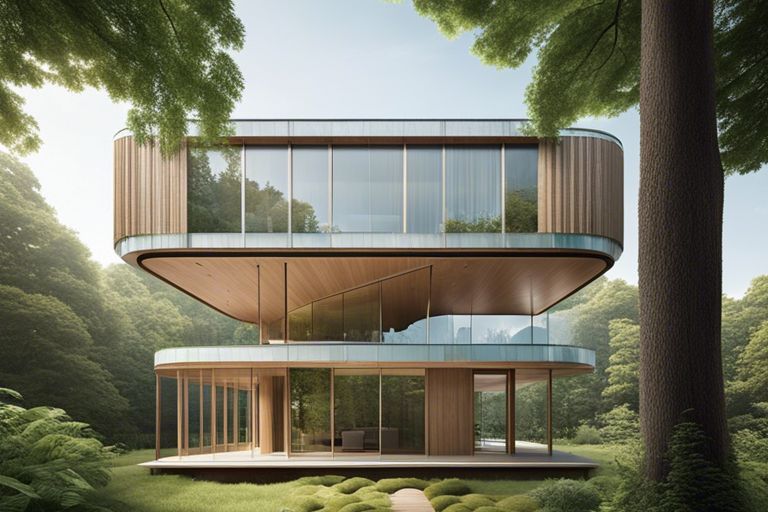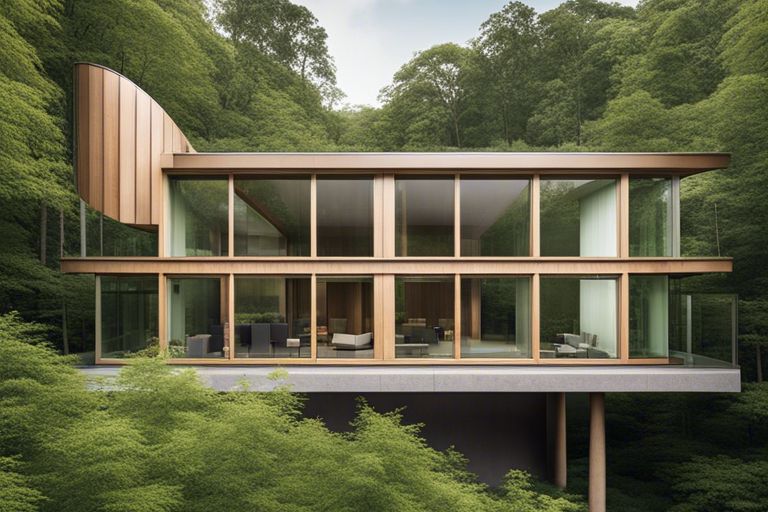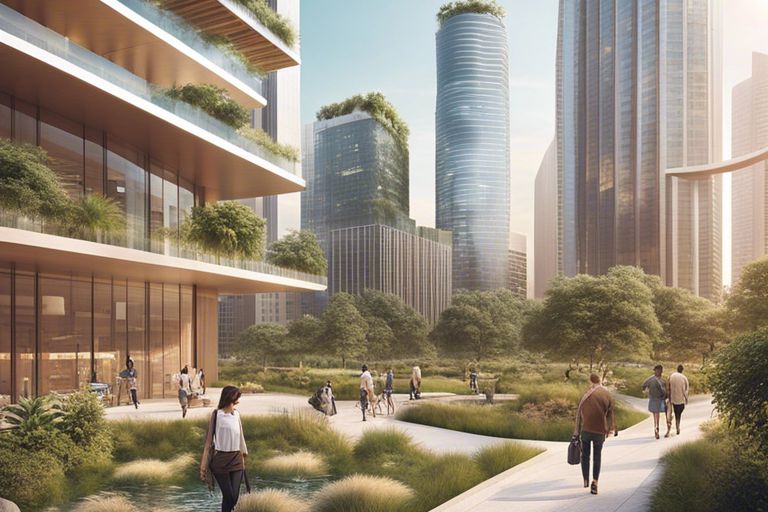Embrace the biophilic beauty of architecture that merges with the natural world around you. Discover how biophilic design creates a sense of harmony and connection between buildings and their environments. Let’s examine into the wonders of blending structures seamlessly with nature, inspired by the timeless principles of Frank Lloyd Wright. Uncover the magic of biophilic design and its ability to transform spaces into poetic reflections of the world outside your window.
Key Takeaways:
- Biophilic design: By incorporating nature into architecture, biophilic design aims to create environments that connect people with nature, enhancing well-being and productivity.
- Seamless blending: Blending buildings with their surroundings involves using natural elements like greenery, light, and water to create a harmonious relationship between the built environment and nature.
- Harmony with nature: Through biophilic design, buildings can not only coexist with nature but also enhance and celebrate the beauty of the surrounding environment, creating a symbiotic relationship between architecture and the natural world.
The Principles of Biophilic Design
A crucial aspect of biophilic design is the seamless integration of natural elements into built environments, creating spaces that promote well-being and harmony with the natural world. By incorporating principles inspired by nature, architects and designers can enhance the connection between individuals and their surroundings, fostering a deeper appreciation for the world around them.
Connecting with Nature’s Rhythms
With biophilic design, you can create spaces that mimic the natural rhythms of the environment, such as the changing seasons, the flow of water, or the cycles of day and night. By incorporating elements like natural light, views of nature, and indoor plants, you can promote a sense of calm and relaxation that aligns with the pace of the natural world. This connection with nature’s rhythms can help reduce stress, improve productivity, and enhance overall well-being.
Incorporating Natural Materials and Textures
Connecting buildings with their surroundings through the use of natural materials and textures is a fundamental principle of biophilic design. By incorporating elements like wood, stone, water, and vegetation, you can create a sense of authenticity and timelessness in your spaces. These materials not only enhance the aesthetic appeal of a building but also evoke a sense of grounding and connection to the earth.
Understanding how to incorporate natural materials and textures effectively is important in creating a harmonious relationship between the built environment and the natural world. By choosing materials that age gracefully and develop patina over time, you can create spaces that celebrate the beauty of imperfection and evolution, reflecting the ever-changing nature of the world around us.
The Importance of Natural Light
One of the important elements in biophilic design is harnessing the power of natural light. Light not only brightens a space but also has a profound impact on your well-being and connection to nature. When designing a building with biophilic principles, incorporating ample natural light is key to creating a harmonious blend between indoor and outdoor environments.
Maximizing Daylight Exposure
Any architect or designer seeking to create a space that fosters a deep connection with nature understands the importance of maximizing daylight exposure. By strategically placing windows, skylights, and open spaces, you can invite sunlight to flood your interior, creating a warm and inviting atmosphere that mimics the outdoors.
Using Light to Create Ambiance
Using natural light to create ambiance is a transformative design strategy. A well-designed space that harnesses sunlight can evoke different moods throughout the day, from energizing and vibrant in the morning to calming and peaceful in the evening. You can play with light and shadow to accentuate architectural features and bring the beauty of the outdoors inside, enhancing your connection to the natural world within the built environment.
Bringing the Outdoors In
Your What is Nature Centric Biophilic Interior Design? options are expanded when you bring the outdoors into your living spaces. Biophilic design principles can be integrated into your home through various techniques that allow you to feel connected to nature even when indoors.
Integrating Plants and Green Walls
The integration of plants and green walls is a key element of biophilic design. Adding live plants to your interior not only adds a touch of greenery but also improves air quality and creates a sense of vitality in your space. Green walls, covered in lush vegetation, can recreate the feeling of being in a natural environment and bring the benefits of nature inside your home.
Creating Seamless Transitions between Indoors and Outdoors
To enhance the connection between your indoor and outdoor spaces, consider using large windows or glass doors that offer unobstructed views of your surroundings. This design choice not only increases natural light in your home but also blurs the boundaries between inside and outside, making you feel as though you are part of the natural world even when you are indoors.
Creating a seamless transition between your indoor and outdoor spaces can improve your overall well-being by allowing you to feel connected to nature throughout your day, whether you are relaxing inside or spending time in your outdoor environment.
The Role of Water in Biophilic Design
For centuries, water has played a vital role in connecting humans to nature. In biophilic design, incorporating water elements can greatly enhance the connection between your built environment and the natural world. Water features and fountains not only add a touch of tranquility and serenity but also create a sense of harmony and balance. By integrating these elements into your space, you can invite the sights and sounds of nature right to your doorstep.
Incorporating Water Features and Fountains
The presence of water features and fountains can transform bland architectural spaces into dynamic, soothing retreats. Whether it’s a small reflective pond, a cascading waterfall, or a bubbling fountain, these elements evoke a sense of calm and relaxation. The gentle movement and sound of water can help mask unwanted noise from urban surroundings, creating a peaceful oasis in the midst of bustling city life.
Using Water to Create Soothing Sounds and Visuals
The trickling of water can have a mesmerizing effect on your mind, helping you unwind and de-stress after a long day. Integrating water features that produce soothing sounds can enhance the overall ambiance of your space, making it a tranquil sanctuary where you can recharge and reconnect with nature. Additionally, the visual appeal of water elements like ponds or streams can add a touch of natural beauty and elegance to your surroundings, creating a harmonious blend between the man-made and natural elements in your design.
Design
In biophilic design, the strategic placement of water features is imperative to create a seamless integration with your surroundings. Consider incorporating water elements near seating areas or outdoor spaces where you can fully appreciate their calming effects. Whether you choose to install a small fountain on your patio or create a meandering stream in your garden, the presence of water can significantly enhance your connection to the natural world, promoting a sense of well-being and harmony in your living environment.
The Psychology of Biophilic Design
How Nature Impacts Human Well-being
To truly understand the essence of biophilic design, you must probe into how nature impacts your well-being. Nature has a profound impact on your mental and physical health. When you are surrounded by greenery, natural light, and elements such as water and wood, your stress levels decrease, your mood elevates, and your overall well-being improves. The connection to the natural world is ingrained in your biology, and incorporating it into your living and working spaces can significantly enhance your quality of life.
Designing for Emotional Connection and Comfort
For emotional connection and comfort, biophilic design taps into your innate yearning for nature. By incorporating natural elements into your surroundings, such as indoor plants, natural materials, and views of the outdoors, spaces can be transformed into soothing sanctuaries that nurture your emotional well-being and promote a sense of calm.
Human beings have evolved in nature for thousands of years, and our modern-day disconnect from the natural world can have detrimental effects on our health and happiness. Biophilic design seeks to bridge this gap by creating environments that reconnect you with nature, fostering a sense of peace and harmony in your daily life.

Overcoming Challenges in Biophilic Design
Many challenges can arise when trying to incorporate biophilic design into architecture, but these can be overcome with careful planning and execution. One of the main challenges is balancing aesthetics and functionality in the design process.
Balancing Aesthetics and Functionality
Any successful biophilic design must find the equilibrium between creating visually appealing spaces and ensuring they are practical and efficient. Incorporating natural elements such as green walls and water features can enhance the beauty of a building, but they must also serve a purpose and not impede the functionality of the space. It requires a deep understanding of both design principles and environmental psychology to strike this delicate balance.
Addressing Climate and Environmental Concerns
Any biophilic design project must also take into account climate and environmental concerns to be truly sustainable. By integrating features like passive heating and cooling systems, efficient lighting, and utilizing natural ventilation, buildings can reduce their ecological footprint and promote a healthier environment. Addressing these concerns is crucial in creating a harmonious relationship between architecture and nature.
On top of that, incorporating green spaces and natural elements not only enhances the aesthetics of the building but also benefits the environment by providing habitats for wildlife, reducing heat island effects, and improving air quality. By designing with nature in mind, you can create spaces that not only look beautiful but also contribute positively to the surrounding ecosystem.
To wrap up
As a reminder, blending buildings seamlessly with their surroundings through biophilic design allows you to create spaces that not only look beautiful but also evoke a sense of connection to nature. By incorporating natural elements, such as greenery, natural light, and water features, you can design spaces that are not only aesthetically pleasing but also promote well-being and harmony with the environment.
Next time you commence on a building project, consider how you can incorporate biophilic design principles to create a space that not only serves its function but also enhances the natural beauty of its surroundings. By embracing biophilic design, you can create spaces that not only look good but also feel good, promoting a sense of tranquility and connection to the natural world.
FAQ
Q: What is biophilic design?
A: Biophilic design is an innovative approach that seeks to connect buildings with nature by incorporating natural elements, such as plants, natural light, and water features, into the design. This design philosophy aims to create harmonious and sustainable spaces that enhance the well-being of occupants.
Q: How does biophilic design blend buildings seamlessly with their surroundings?
A: Biophilic design blends buildings seamlessly with their surroundings by mimicking natural shapes, colors, and textures in the architectural elements. By incorporating elements like green roofs, large windows, and open outdoor spaces, buildings can become an extension of the natural environment, creating a sense of unity and balance.
Q: What are the benefits of incorporating biophilic design in buildings?
A: Incorporating biophilic design in buildings has numerous benefits, including improved air quality, reduced stress levels, increased productivity, and enhanced overall well-being. By fostering a deep connection with nature, biophilic design can transform spaces into tranquil and revitalizing environments that nourish both the body and the spirit.

